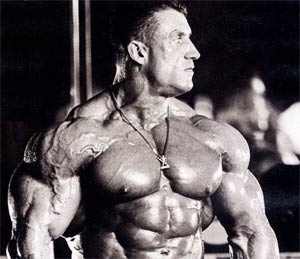Fitness Articles
About this Site l Contact l Free Newsletter l Subscribe to Rss Feed
Recommended Products l Fitness Store l Directly Fitness Store
Recommended Products l Fitness Store l Directly Fitness Store
Check out the H.I.T. training routine here
By:Alex Borja
Subscribe


Meet Dorian Yates, a pro bodybuilder who follows the H.I.T. principles


Training with high intensity can lead to overtraining very quickly
Keeping an exercise log may be just what you need




H.I.T. TRAINING PRINCIPLE REVIEW
fitness articles:
Subscribe.
Share.
Donate.
Author: Alex Borja
H.I.T TRAINING: A REVIEW OF IT'S PRINCIPLES
H.I.T. training or “high intensity training" is a controversial but effective way to build strength and size in muscles. The main focus of H.I.T. training is to train to fatigue every set with slow controlled movements and high load. Essentially this means that you will train with a low volume of exercises at high intensity. This is in contrast to the traditional method which calls for sub maximal effort with high volume (lots reps and sets). It was introduced by the Nautilus equipment owner Arthur Jones. He and many others believe this to be the most effective way to quick gains relating to strength and muscular size.
Although H.I.T. training is a high intensity activity, it does not entail quick, powerful movements and burst of energy. This fact leads to a safer form of effective training while overloading your muscles at the same time. An example of power training would be exercises such a power cleans or plyometric training. Many sport training programs will argue that you need power exercises that will carry over into sports.
Athletic team members say that H.I.T. training is not going to train the type of muscle fibers needed for power sports. H.I.T. advocates would say that the fast twitch fibers stimulated will provide plenty of carry over into sport related activities. H.I.T. believers also argue it is much safer and dangerous to load the joints. Sub maximal exercise is believed to be inadequate for real muscle growth and strength by H.I.T. followers and is why they recommend it for athletic training programs. We now start to see even the most professional of teams implementing H.I.T. training into their programs or variations thereof.
In this guide I will explain and go through both the pros and cons of H.I.T. training. I will also give my own take on each component that is mentioned. This article is not meant to be bias one way or the other, simply to inform you of what H.I.T. training entails and if it is for you in the end. Although my own opinions are placed remember that they are MY opinions and I simply try to use logic to explain the reasoning and/or faults behind each principle. What you do in the end is up to you.
The Principles of H.I.T. Training
1. Principle: For H.I.T. training you must attempt to increase either the resistance or repetitions used at every workout. The idea is that this will force your muscles into adapting at an increased pace due to the increased stress you place on them. This is why H.I.T. training recommends long break in between training the same body parts.
Opposing view: Some would say this is also counter-effective because you will only over stress your muscles causing them to breakdown. This would cause no gain in strength or muscle mass and be detrimental to your health.
My opinion: I think that it is safe to say that H.I.T. training will indeed require a higher level of stress to be placed on the muscle. The question is if your body is ready to handle it. If I were to try H.I.T. training I would be sure to easy into it and see how my body responds. If my body cannot simply recover fast enough at first I will add another rest day to my routine. If I find my body recovers quickly than this program may accelerate my potential quicker.
2. Principle: In H.I.T. training you must incorporate high weights usually in the 1-3 rep range. With such a high weight it is argued that you will increase those fast twitch muscle fibers and causes strength and size gains. This rep range is due to the high intensity and low volume principles applied to the H.I.T. method. If you were truly the high intensity principle of H.I.T. training with high weights it would have to be using low reps. You wouldn’t be able to bench maximal weight more than 3 times. This is what advocates of H.I.T. training say is so effective about it.
Opposing view: This goes against what type of muscle makeup you were born with to train to your true potential. H.I.T. training uses faster twitch muscle fibers (type I). So if you were naturally made up of the opposite fibers (type II) then how could you possibly benefit greatly from H.I.T. training?
My opinion: I believe that you will see improvement with H.I.T. training regardless of the genetic muscle type you predominately are born with but it is better to use this form of training if you are a fast twitch guy. An endurance (predominately slow twitch fiber) guy isn’t going to see as much improvement to H.I.T. training as a power athlete.
3. Principle: In H.I.T. training intensity must be maximal and achieved through high weights and low volume. The idea is to reach muscular fatigue at every set of every exercise you do. Failure to reach this high level of intensity will result in minimal gains. Additional “post repetitions” are often added onto the end of a set for further fatigue and can consist of negatives or partial reps.
Opposing view: Fatigue is simply the point at which you cannot possibly complete another repetition due to fatigue of the muscles. It can be argued that you can achieve muscular fatigue from high volume low weight reps. It will take longer for those same muscles to fatigue in this way but the end result is argued to be the same-- muscular fatigue.
My opinion: I am inclined to go with both sides of the story on this one. While you can reach absolute muscular fatigue with any method as long as you train until you cannot perform another rep, I believe the mind to play an important part in intensity levels. I think H.I.T. training is onto something in this aspect as it takes much more focus and willpower to go through a high weight, slow contraction, and low volume exercise than a light, high volume exercise.
What I don’t agree with is that this is the ONLY way to achieve true muscular fatigue and intensity as there are many ways to accomplish this. You can add reps, increase weight, add partials, gets “psyched up” for a workout, supplementation, increase the number of exercises to a given body part, increase the number of sets, decreasing rest between sets, increases time in eccentric portions of exercises, and much more. This goes to show that it is entirely possible with all these possible combos of intensity. I think H.I.T. is effective in this area, but certainly not the ONLY way to get maximal intensity.
4. Principle: You must use proper technique with each exercise. It would important not to lose this proper form especially with high weight loads. The idea with this principle is to simply keep safe while lifting to maximize gains.
Opposing view: It would not be safe to use H.I.T. training with proper form because it would be nearly impossible. Those in this group tend to agree that proper form should be used but can’t agree that it is possible with such a heavy load and surely not safely.
My opinion: I would have to say that proper form is first and foremost the most important aspect of weight lifting—in any program. Without this you are prone to injuries (trust me I should write a book on my experiences) and sub maximal gains.
Growing up I have experimented with many programs, exercises, and methods. I know that no matter the program and without proper form, it hurts. If there is one message you leave here today with let it be that FORM IS EVERYTHING. While there are many variations and “cheat” methods to gains (and actually do work), they are done in a safe and "controlled" way when implemented properly and should only be used by fitness experts. If you want to learn more on proper form I have an Exercise Guide within this site for just that reason.
I would say that it would be very hard to use proper form with heavy loads and would take complete focus and knowledge of the exercises to perform such feats. Safety could even become an issue as many exercises would be dangerous done slowly. I would say that unless you know your anatomy, proper form, and have a strong focused mind, H.I.T. training may be dangerous for you.
5. Principle: By the end of your set you should reach concentric failure. The idea is to reach absolute muscular fatigue during each set of your training program. This is done by attempting a final rep but not quite achieving it during the concentric part of the phase of the lift (as opposed to eccentric).
Opposing view: It is unnecessary to fatigue your muscles maximally during each set. This can lead to too much muscle damage and not enough recovery time will be available with this workout program.
My opinion: I would say that fatigue is necessary to build stronger muscles. Without fatigue you simply won’t get stronger. As I stated before, I believe there to be multiple ways to do this and the H.I.T. program is just one of them. I also know that different body parts vary on the “perfect” rep range. This is all dependent on those muscle fiber types, type I and II. For instance, the lower back is full of heavy endurance fibers (type I) and therefore requires more than just 3 reps to exhaust them. They are not designed to move very heavy loads and I believe could be jeopardizing safety and taking away potential for your gains.
If you want to work solely those muscle groups that are primarily (or more so) type II fibers, then by all means you may benefit from H.I.T.’s principles. If you are an endurance type person I would recommend sticking with higher reps than this program implements.
6. Principle: Training should be within a one hour time frame. This is meant to get the user in and out of the gym. The high intensity levels within this program are not meant to go on for very long as glycogen and energy stores will deplete fast.
Opposing view: This is a long length of time to be doing maximal exercises. Not all people will benefit from this type of training.
My opinion: I would agree that this training should go on for no more than an hour and that’s pushing it. Even with the long rest times in between sets, if you are truly training to your max every time, one hour will seem like forever. I’ve been there and from my personal experience with H.I.T. training I can say that this training is NOT for everyone. You have to be focused, determined, and have strong willpower to succeed in getting close to that hour mark. If you find it easy to get to 1 hour with this program--try going at least 80% of true maximal effort next time and see how you feel.
7. Principle: Train your muscle groups from largest to smallest. The idea here is to use your main glycogen and ATP (energy) stores early on so you don’t get exhausted toward the end of the workout. This is based behind the idea that larger muscles need more fuel than their smaller comrades.
Opposing view: Depending on your goals and weaknesses you should train variations of muscle groups first or last.
My opinion: I will elaborate on the opposing view a bit because I agree with both statements here. Yes training from largest to smallest is a very common and smart procedure with lots of reasoning behind it. The only issue I have is when people have certain muscle imbalances or weaknesses. These people should train to their weaknesses first regardless of muscle size to adapt body balances and increase safety.
I will speak on H.I.T.’S behalf by noting the fact that people with imbalanced muscles or weaknesses should not be embarking on this program. This is meant to be a moderate to expert level program to help those who are well educated, fit, and have no prior issues that would hinder safety.
8. Principle: Emphasize major muscle groups. The idea here is to place most of your time on the bigger muscles because your smaller muscles don’t need as much training.
Opposing view: This will only cause weakness in those smaller muscle groups.
My opinion: I think that training larger muscles first has its value but can also eventually lead to possible muscle imbalances. If you train back and chest very hard every time while ignoring forearms you may injure your forearms at some point because the ratio of strength between the large and smaller muscles has increased.
As long as you don’t notice that you’re lower legs, shoulders, or forearms are starting to get considerably weaker in comparison to your trunk than go for it. I would just recommend keeping a close watch as you go along. Examples of this weakness would be your unstable during a bench press (shaky at wrist or shoulders) or maybe your grip feels weak around a dumbbell or bar.
9. Principle: Train 2-3 times per weeks on nonconsecutive days. The idea here is to do full body workouts on a few times a week to allow time to recover.
Opposing view: It can take far more time for your muscles to recover during high intensity activities than what is assumed in the program.
My opinion: I would say that everyone is different for this one. Some will recover fast and others won’t. From my personal experience it all depended on how much sleep I got, my diet, and other social factors. Placing stress on your body during this program is destructive and will delay your recovery.
Muscles usually recover within 48-72 hours but not always. Other factors such as which muscles you used, gender, fiber type, age, stress, intensity, etc., all play a role in recovery.
Remember these key components of recovery:
* Large muscles recover slower than smaller muscles
* Males usually recover faster than females
* Type I fibers recover faster than type II
* The older you are, the longer the recovery time needed
* High stress = Long recovery time
* The higher the intensity the higher the recovery needed
If you seem to recover quickly that’s great and maybe you can tolerate H.I.T. but if you take longer than you might want to reconsider starting this program. As you go along in the program you may find your recovery time is decreasing as your body adapts.
10. Principle: Keep detailed exercise logs. The idea is to have exactly what you did in paper form so you won’t have to remember every little detail (if that were even possible).
Opposing View: Constantly looking over your notes during your workout will be detrimental to your focus and/or breaks in between sets.
My opinion: In my mind there is absolutely nothing wrong
with this principle. It can be very productive as you can
record weight used, reps, sets, how you felt during training,
and anything else you may want to make note of. I personally
did it for a while but then realized it was very annoying to tote
it around, would lose my focus, and lose track of my workout.
This is just me but I like to train based on “feel” and not by
beating my last record. If I’m feeling a little less energized that
day I may decrease the weight a bit and vice versa. I just think
you will not be able to train with the exact same energy,
motivation, focus, stress level, etc., in every workout so why
should the weight stay the same (or worse increase)?
Not saying logs are detrimental, just not for me. Logs can be very beneficial and I strongly recommend having one if you’ve never tried it. I know plenty of people who have had great success with these exercise logs. Try it and see if it’s for you. You can find a list of helpful exercise and diet logs on this site.
To reiterate the H.I.T. training program I will list the principles for your use below should you base your program around it. You can even strive to modify your own H.I.T. program by replacing “bad” components with “good” ones mentioned in this article. I would make it a whole body exercise plan with 3-4 exercises of larger muscle groups and 2-3 of smaller groups. Be sure to plenty of rest and lots of food—you’ll need it for recovery. Remember to take long breaks and be creative with your workout design!
H.I.T. Training Program Principles
1. Principle: For H.I.T. training you must attempt to increase either the resistance or repetitions used at every workout.
2. Principle: In H.I.T. training you must incorporate high weights usually in the 1-3 rep range.
3. Principle: In H.I.T. training intensity must be maximal and achieved through high weights and low volume.
4. Principle: You must use proper technique with each exercise.
5. Principle: By the end of your set you should reach concentric failure.
6. Principle: Training should be within a one hour time frame.
7. Train your muscle groups from largest to smallest.
8. Emphasize major muscle groups.
9. Train 2-3 times per weeks on nonconsecutive days.
10. Principle: Keep detailed exercise logs.
If you've found this website helpful, please click the Donate button. Thanks for the support.
Read through more fitness articles: Fitness Articles Home
Like the site? Sign up for the FREE newsletter. I'll send a new article once or twice a month. Unsubscribe
anytime.
anytime.


